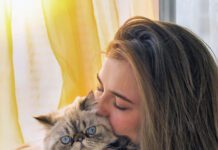Help! A 2-Year-Old Cat Has Begun Pulling Out His Fur in Clumps
Q: My 2-year-old cat, who we took in as a stray after gradually gaining his trust about a year ago, has been having a problem that I wonder if you can help with. He has started to pull his fur out in small cotton ball-sized clumps. I find these clumps all over the house, and it’s driving me crazy. He is an indoor/outdoor cat and there are no other pets or kids in the house. Can you provide some insight?
A: Thanks for getting in touch, and I understand that this behavior must be quite disconcerting. I think it may be helpful to consider the potential causes as arising from two general categories: medical and behavioral. While there may be some overlap between these two categories with respect to causes of self-epilation (selfremoval of hair) in a given cat, breaking this down into two categories can be helpful to understand potential causes in an effort to stop this behavior.
The first thing to do is to visit your cat’s veterinarian to rule out medical causes. Perhaps the most obvious cause would be ectoparasites like fleas, mites, or lice. While it may seem that some of these parasites would be easily identified by owners, flea and louse infestations can be notoriously difficult for cat owners to identify even though fleas and lice (and their eggs), although very small, are generally visible to the naked eye.
Mites are generally not visible to the naked eye (they must be visualized under a microscope). In the case of ectoparasites, cats are often itchy. Fungal skin infections such as ringworm may also cause a cat to become itchy and to overgroom himself, thereby damaging his fur.
Allergies to either inhaled allergens or to foods can also cause cats to be itchy and to damage their coats. Allergies to inhaled allergens (called atopic disease) may be seasonal, as the allergens may be more prevalent in the environment during particular times of the year (i.e., when certain species of plants are blooming or when a cat is kept indoors during cold weather, increasing exposure to indoor molds and/or dust mites).
Allergies to specific components of food can be ruled out by systematically eliminating potential allergens from the diet and monitoring a cat’s response. In rare cases, cats may also develop an allergic reaction to various medications or to things that parts of their bodies come into contact with in their environment (i.e., carpet cleaners, other household cleansers).
A number of medical conditions, including hyperthyroidism, anal gland impaction, osteoarthritis and certain neurologic problems, may cause a cat to excessively groom and to damage his fur. It’s important to have his veterinarian rule these out before assuming that your cat’s problem is behavioral/psychological.
Cats may excessively groom/damage their fur for behavioral/psychological reasons. Stressors such as inadequate exercise/mental stimulation, social isolation, territorial conflict, changes in environment, changes in daily routine, and/or addition or removal of family members or pets can all cause a cat to inappropriately groom. Cats with feline hyperesthesia syndrome that causes rippling of the skin and self-mutilation may also excessively groom.
Managing cats who demonstrate behavioral/psychogenic excessive grooming often involves behavior modification, measures to reduce stressors in the environment and, in some cases, drug therapy (sedatives, antidepressants). Developing the optimal management strategy may require consultation with not only your cat’s veterinarian but also with a veterinary behaviorist, and the veterinarian is best equipped to determine whether a behaviorist may be helpful.
I hope this is helpful. While I understand how distressing this behavior can be for you, please know that with careful work-up and the development of appropriate management strategies, most cats demonstrating this type of behavior can be dramatically improved and can live happy, healthy lives.
Best of luck with your baby, and please let us know how things are progressing when you can.
—Sincerely, Elizabeth



